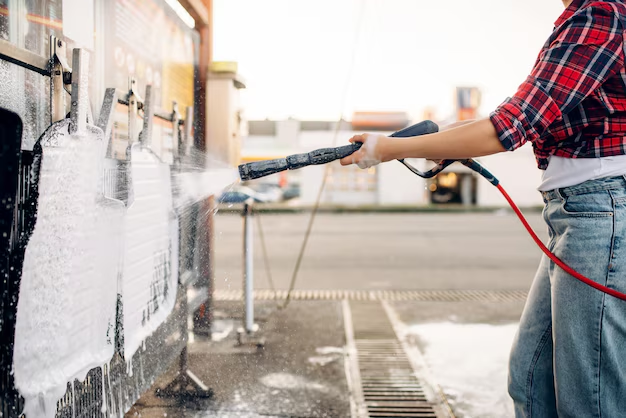
Pressure Washing (also known as power washing) is a highly effective cleaning method that uses a high-pressure water spray to remove dirt, grime, mold, mildew, algae, and other contaminants from outdoor surfaces. It’s especially useful for surfaces that are tough to clean with regular methods, such as driveways, patios, fences, roofs, and building exteriors.
- Improved Curb Appeal: Pressure washing instantly improves the look of your property by removing unsightly stains and dirt from surfaces.
- Time-Efficient: It’s much quicker than manual scrubbing and can clean large areas in a fraction of the time.
- Preventative Maintenance: Regular pressure washing can prevent the buildup of harmful substances like mold and mildew, which could cause long-term damage to surfaces.
What Does Pressure Washing Include?
Pressure washing is versatile and can be applied to a variety of surfaces. Here are the most common areas where pressure washing is used:
1. Driveways and Sidewalks:
- Cleaning Oil and Grease Stains: Pressure washing can remove stubborn oil stains and grease buildup from concrete, asphalt, and other driveway surfaces.
- Debris and Dirt: It efficiently washes away dirt, leaves, and other debris, leaving your driveway looking fresh and clean.
2. Patios, Decks, and Outdoor Spaces:
- Mold and Mildew Removal: Outdoor spaces like patios and decks can accumulate mold and mildew over time. Pressure washing helps remove these contaminants and restore the original appearance of these surfaces.
- Cleaning Pavers and Tiles: Pressure washing works well for cleaning stone or brick patios and walkways, removing moss, algae, and dirt build-up.
3. Home Exteriors and Siding:
- Vinyl, Brick, and Stucco: Pressure washing can restore the look of your home’s exterior by removing dirt, spider webs, and stains. For vinyl siding, it helps keep the home looking bright and clean without damaging the material.
- Pre-Painting Prep: It’s often used to clean the exterior of a home before painting, ensuring that the surface is clean and free of contaminants that could interfere with paint adhesion.
4. Roof Cleaning:
- Moss and Algae Removal: Pressure washing can effectively remove moss, algae, and lichen from roof shingles or tiles. However, it’s important to use the correct pressure to avoid damaging shingles.
- Improved Curb Appeal: Cleaning the roof gives your home a fresh, well-maintained appearance.
5. Fences and Gates:
- Restoring Wood or Vinyl Fences: Over time, wood fences can accumulate dirt, moss, and mildew. Pressure washing can remove these contaminants and refresh the wood’s natural color. Vinyl fences also benefit from pressure washing to remove dirt and algae growth.
6. Driveways and Garage Floors:
- Concrete and Stone Surfaces: Pressure washing is an excellent way to clean concrete surfaces like driveways, garage floors, and patios. It removes grime, dirt, and oil stains that can make surfaces look worn out.
7. Commercial Properties:
- Building Exteriors: For businesses, pressure washing is great for keeping the outside of buildings looking professional and clean, which can help improve the property’s curb appeal.
- Parking Lots and Walkways: Businesses can also use pressure washing to maintain parking lots, walkways, and entrances.
